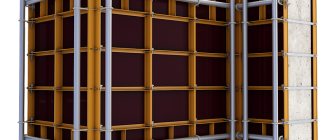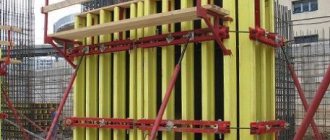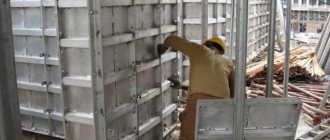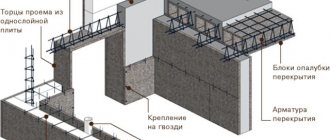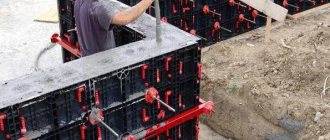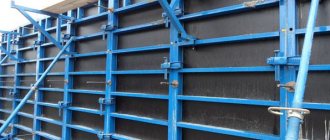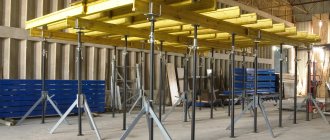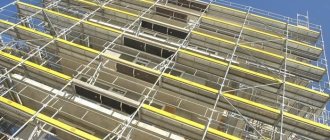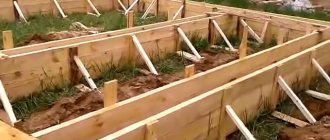FORMWORK “GAMMA” FOR WALLS
Wall formwork "Gamma" is intended for concreting monolithic walls of above-ground and underground structures and includes a number of auxiliary devices that ensure its installation in the design position, alignment and maintenance during work.
Characteristics:
| Name | Meaning |
| Profile thickness | 3.5mm |
| Permissible load | 90 kN/m2 |
| Shield turnover | more than 400 times |
| Deflection at permissible load no more | L/400 |
| Height of standard panels | 3.00m, 3.30m |
| Width of panels, mm. | 300 — 1200 |
| Weight 1m² | 55kg. |
Linear formwork panels "Gamma" are designed for forming straight sections of walls. The shield is made of a solid-rolled steel profile 3.5 mm thick with a closed section and reinforced with stiffening ribs from the same profile. The shield deck is made of laminated plywood with a thickness of 18 mm and a density of 220 g/m2. The ends of the plywood perimeter are protected with a waterproof coating in accordance with GOST 3916.1-96. This coating is similar to the coating that protects the ends of plywood during its production.
Large-panel combined formwork Gamma-Cascade is designed for concreting monolithic walls of structures of any configuration in plan, as well as foundations and basement walls. The formwork design complies with the requirements of class I GOST R 52085-2003. The formwork consists of a set of panels that absorb all the loads during concreting and auxiliary devices that ensure its installation in the design position, alignment and maintenance during the work. The boards are connected into cards up to 6.0 m long and no more than 3.6 m high using special locks. If necessary, cards can be expanded using horizontally placed shields, the design of which allows them to be assembled in any combination.
Characteristics:
| Name | Meaning |
| Profile thickness | 3.0 mm |
| Permissible load | 90 kN/m2 |
| Shield turnover | more than 400 times |
| Deflection at permissible load no more | L/400 |
| Height of standard panels | 3.00 m, 3.30 m |
| Width of panels, mm. | 300 — 1200 |
| Weight 1m2 | 50 kg |
Linear panels are designed to form straight sections of walls. They are a welded frame made of solid-rolled steel profile 3 mm thick with a closed section and stiffening ribs. The deck is made of laminated plywood 18 mm thick, 220 g/m2, protected at the ends with a waterproof coating in accordance with GOST 3916.1-96. This coating is similar to the coating that protects the ends of plywood during its production. The width of the panels is from 300 to 1200 mm. The height of the shields is 3.3 m; 3.0m; 1.5m. At the Customer's request, boards are produced in any width from 300 to 1200 mm in increments of 10 mm.
“GAMMA-RADIUS” formwork is intended for concreting monolithic vertical curved (radius, elliptical) elements of buildings and structures with a radius of 3 meters and is compatible with large-panel formwork of the “GAMMA”, “GAMMA 330” and “Gamma-Cascade” series. The formwork design complies with the requirements of GOST R 52085-2003. The formwork consists of a set of panels that absorb all the loads during concreting and auxiliary devices that ensure its installation in the design position, alignment and maintenance of the formwork during work. The panels are connected into mounting panels using universal GAMMA locks. The shields have a height of 3 and 3.3 meters. If necessary, it is possible to produce panels up to 6 m high.
Characteristics:
| Name | Meaning |
| Permissible load | 80 kN/m2 |
| Deflection at permissible load no more | L/400 |
| Minimum radius | 3.0 m |
| Height of standard panels* | 3.00 m, 3.30 m |
| Width of panels, mm. (external/internal) | 1360/1280 |
| Weight 1m2 | 50 – 80 kg |
The Gamma buttress system is designed to absorb the load from concrete and hold formwork panels during one-sided concreting (without the use of tie bolts). Buttress elements are installed in assemblies of 2 (or 3) elements. The installation step of the buttress frames is determined by each specific project and depends on the height of the concrete wall and the concreting speed. Elements of buttresses can be used in conjunction with both beam-transom and panel formwork.
FORMWORK FOR MONOLITHIC WORKS GO
Formwork fasteners
In addition to formwork systems, our company offers a wide range of components for formwork made in Germany by Dywidag: tie-bolt, nut, nut-plate, coupling, waterstop, anchor, cone, clamp, tools and special devices.
Order products right now or check out the range:
Our most popular components include: formwork wing nuts (wing nut, formwork nut, tie nut), tie bolts (tie, tie rod, pin, tie screw), hinge nuts (Super plate nut), hex nuts, wedge locks for formwork and other components that are used on construction sites.
Wing nuts and formwork ties are the main elements when pouring vertical surfaces, regardless of the formwork system used and the complexity of the object. It is these formwork components that absorb the entire load from the pressure of fresh concrete. In this regard, it is especially important that these components withstand the required load and do not operate at the limit of their capabilities.
STM offers high-quality imported galvanized wing nuts with a diameter of 100 and 70 mm, which meet international standards, both in quality and in terms of permissible load, which is 20 tons. Our company also has a powerful hinge nut, which has an increased support area and allows you to install the tie at an angle of up to 10 degrees.
The SeverTrnasMonolith hex nut is used in places where it is impossible or impractical to use wing nuts. This nut is used for installing formwork panels in a horizontal position when pouring foundations, fastening scaffolding, joining formwork panels to each other and in many other cases. Despite its miniature size, the hex nut can withstand consistently high loads, just like the wing nut.
Formwork tie bolts are manufactured in various lengths. The most popular (standard) length of the tie rod is 1000 mm, which is sufficient for pouring standard walls and foundations. However, quite often our customers require clamping bolts of other lengths. In this case, we are ready to cut the screed to any size at the client’s request in the range from 500 to 6000 mm completely free of charge.
To ensure that there are no problems with screwing nuts onto a coupling bolt at a construction site, our specialists must chamfer the entry of the nut. The fact is that after cutting the tie, “burrs” can form, which can lead to jamming of the nuts. This chamfering service is also provided by our company completely free of charge. It is important for us that our clients receive high-quality formwork components that are ready for use and do not have to waste their time on modification.
| Wing nut DW15 D=100 mm. | ||||
| Dimensions (mm) | Thread diameter (mm) | Max. load (kg) | Weight, kg) | |
| 100 | D=15/17 | 20200 | 0,6 | |
| The wing nut DW 15 D=100 mm got its name due to its design features, in particular the presence of wings that allow the nut to be tightened using a hammer or a piece of reinforcement. Wing nuts work in tandem with a pinch bolt, which is why they are very often called a pinch nut . The coupling nut, like other components for formwork, is highly durable. It is a basic element for all types of formwork. Easily installed with a hammer. Wing nut DW 15X100 mm - made of high-strength cast iron FCD500 (Russian analogue of VCh50). The nut has 4 stiffening ribs located perpendicular to each other, forming a powerful frame that resists chipping along the perimeter of the nut. The wing nut is precision cast to ensure that there are no voids or weak spots. High-quality casting of the nuts, especially its base, allows you to evenly distribute the load along the entire perimeter of the nut, preventing distortions (breaking). Each nut must have a chamfer at the base of the thread, which makes it easy to screw it onto the coupling bolt and avoid jamming. | ||||
| Pinch bolt D=15/17 mm. L= up to 6000 mm. | ||||
| Dimensions (mm) | Thread diameter (mm) | Max. load (kg) | Weight, kg) | |
| up to 6000 | D=15/17 | 1.5/p.m. | ||
| Quite often this element is called formwork studs . Despite this, the scope and purpose of the tension screw remains unchanged. The screed works in tandem with wing nuts and directly absorbs the pressure of the concrete mixture. The tie bolt for formwork is made up to 6 meters long. Can be cut to any size at the customer's request within the above limits. The screed has a diameter of 15/17 mm. and thread pitch 10mm. The tie rod is fully compatible with wing nuts, swivel nuts and hex nuts. | ||||
| Wing nut D=90 mm. | ||||
| Dimensions (mm) | Thread diameter (mm) | Max. load (kg) | Weight, kg) | |
| 90 | D=15/17 | 0,47 | ||
| The wing nut has a 90 mm support pad. The formwork nut is made of VCh45 cast iron and has a galvanized coating. This nut has a 15/17 mm thread. and is fully compatible with tie bolts like other formwork components we offer. The fundamental difference from the Wing Nut DW15 D=100 mm is the diameter and the material used. | ||||
| Wing nut DW15 D=70(80) mm. | ||||
| Dimensions (mm) | Thread diameter (mm) | Max. load (kg) | Weight, kg) | |
| 70(80) | D=15/17 | 19900 | 0,48 | |
| The wing nut has a support pad with a diameter of 70 mm. The diameter, taking into account the wing reach, is 80 mm. Installed using a hammer. | ||||
| Hexagon nut DW15 L=50 mm. | ||||
| Dimensions (mm) | Thread diameter (mm) | Max. load (kg) | Weight, kg) | |
| L=50 | D=15/17 | 19100 | 0,21 | |
| A small nut that is used in places where wing nuts are not possible or practical. Often used in special formwork systems. Installed using a 30 mm wrench. | ||||
| Small wing nut DW15 | ||||
| Dimensions (mm) | Thread diameter (mm) | Max. load (kg) | Weight, kg) | |
| D=85 | D=15/17 | 19100 | 0,37 | |
| Wing nut without support pad. The wings reach 85 mm. Most often used as a retainer for screw locks. It has also found its application in non-standard formwork systems. | ||||
| Hinge nut DW15 120X120 mm. (Super plate, Hemisphere board for formwork). | ||||
| Dimensions (mm) | Thread diameter (mm) | Max. load (kg) | Weight, kg) | |
| 115X115 | D=15/17 | 19900 | 1.22 | |
| A powerful nut with an enlarged support platform allows you to install the coupling bolt with an offset of up to 15°. It has proven itself especially well when used in conjunction with round wall formwork, because allows you to compensate for the difference (displacement) of the inner and outer radius. As a result, the load is distributed evenly and the tie rod and nut are in the optimal working position. Installed using a hammer. | ||||
| Wedge lock (crab-shaped) for steel and aluminum formwork on 120/140 profile | ||||
| The wedge lock is made of high-strength cast iron (VCh40). The wedge lock also belongs to the formwork components and performs the function of connecting the formwork panels to each other. The wedge lock is used for joining formwork panels to each other. Compatible with steel and aluminum formwork built on 120 or 140 profiles. The wedge lock for formwork is compatible with both steel formwork Alpha, Gamma, Delta, Techno, etc., and aluminum formwork. Wedge locks have a galvanized coating, which has a beneficial effect on their consumer properties and durability. | ||||
| Universal wedge lock for Delta formwork | ||||
| The universal wedge lock allows you to both connect the formwork panels and level them. The castle has an elongated support beam, which serves as a traverse due to which the formwork elements are aligned. Also, the wedge lock for Gamma formwork allows you to install compensation inserts between formwork panels up to 12 cm wide. Thus, this lock is the most modern and technological solution for joining formwork built on a 120X60 profile. Sometimes this formwork element is sometimes called a “crocodile lock”; it received this name due to the slatted structure and the presence of notches along the entire length of the beam. Compatible with the following types of formwork: “Delta” formwork, “Alpha” formwork, “Techno” formwork, “Gamma” formwork, etc. | ||||
| Universal screw lock for formwork | ||||
| The universal screw lock is used mainly for fixing wooden extensions (compensation inserts) between the formwork panels. The design of this lock allows you to install an insert from 0 to 25 cm, which is very convenient in construction conditions, because Such a wide range of work greatly facilitates the assembly of formwork. Thanks to the use of a tightening screw in the lock design, smooth stepless adjustment is carried out. Thus, the universal screw lock has proven itself to be a reliable and easy-to-use lock. Compatible with almost all formwork systems built on both steel and aluminum profiles. | ||||
| Lock for formwork MSK (connecting bolt) | ||||
| The lock is used to join the formwork elements together. Fully compatible with the German Paschal “Raster” formwork and its Russian analogue – MSK Formwork. | ||||
Advantages of permanent formwork
Installation of permanent formwork involves purchasing a ready-made kit for performing the work. All that remains is to assemble the structure and install it. This leads to a number of advantages that formwork of this type has:
- short deadlines for completing work;
- ease of installation;
- low weight of the structure;
- resistance to fungus and mold;
- fire safety;
- low cost.
Also, permanent formwork is both a layer of insulation and consists of foam blocks that are easily connected to each other. In this case, the inner wall is thinner than the outer one. Thanks to this, a high level of thermal insulation is achieved.
